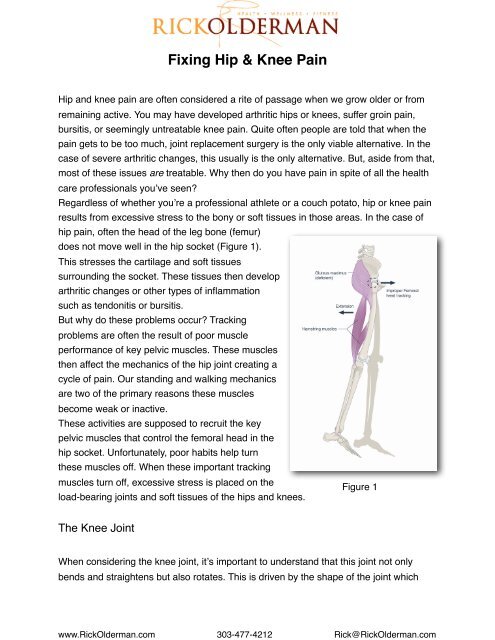Fixing Hip & Knee Pain - Rick Olderman
Fixing Hip & Knee Pain - Rick Olderman
Fixing Hip & Knee Pain - Rick Olderman
You also want an ePaper? Increase the reach of your titles
YUMPU automatically turns print PDFs into web optimized ePapers that Google loves.
www.<strong>Rick</strong><strong>Olderman</strong>.com 303-477-4212 <strong>Rick</strong>@<strong>Rick</strong><strong>Olderman</strong>.com<br />
<strong>Fixing</strong> <strong>Hip</strong> & <strong>Knee</strong> <strong>Pain</strong><br />
<strong>Hip</strong> and knee pain are often considered a rite of passage when we grow older or from<br />
remaining active. You may have developed arthritic hips or knees, suffer groin pain,<br />
bursitis, or seemingly untreatable knee pain. Quite often people are told that when the<br />
pain gets to be too much, joint replacement surgery is the only viable alternative. In the<br />
case of severe arthritic changes, this usually is the only alternative. But, aside from that,<br />
most of these issues are treatable. Why then do you have pain in spite of all the health<br />
care professionals youʼve seen?<br />
Regardless of whether youʼre a professional athlete or a couch potato, hip or knee pain<br />
results from excessive stress to the bony or soft tissues in those areas. In the case of<br />
hip pain, often the head of the leg bone (femur)<br />
does not move well in the hip socket (Figure 1).<br />
This stresses the cartilage and soft tissues<br />
surrounding the socket. These tissues then develop<br />
arthritic changes or other types of inflammation<br />
such as tendonitis or bursitis.<br />
But why do these problems occur? Tracking<br />
problems are often the result of poor muscle<br />
performance of key pelvic muscles. These muscles<br />
then affect the mechanics of the hip joint creating a<br />
cycle of pain. Our standing and walking mechanics<br />
are two of the primary reasons these muscles<br />
become weak or inactive.<br />
These activities are supposed to recruit the key<br />
pelvic muscles that control the femoral head in the<br />
hip socket. Unfortunately, poor habits help turn<br />
these muscles off. When these important tracking<br />
muscles turn off, excessive stress is placed on the<br />
Figure 1<br />
load-bearing joints and soft tissues of the hips and knees.<br />
!<br />
The <strong>Knee</strong> Joint<br />
When considering the knee joint, itʼs important to understand that this joint not only<br />
bends and straightens but also rotates. This is driven by the shape of the joint which
www.<strong>Rick</strong><strong>Olderman</strong>.com 303-477-4212 <strong>Rick</strong>@<strong>Rick</strong><strong>Olderman</strong>.com<br />
dictates that it must rotate while bending and straightening (Figure 2). Rotation turns out<br />
to be the biggest factor in creating knee pain. But there are precious few muscles in the<br />
knee joint that control rotation.<br />
So if rotation causes knee pain and there arenʼt<br />
any muscles to control rotation in the knee then<br />
how do we fix knee pain? Well if you remember,<br />
there are muscles in the pelvis that control the<br />
tracking of the hip joint. These same muscles<br />
control rotation of the leg bone which is one half<br />
of the knee joint.<br />
The other half (the lower leg bone) is controlled<br />
by the foot. So we then need to think about how<br />
our walking habits may be affecting the knees<br />
and hips.<br />
The knee joint is basically caught in<br />
the middle of these two giants (the pelvis and Figure 2<br />
the foot). It may be reacting to one or the other or both.<br />
Letʼs look at your standing and walking habits for a moment. Do you often lock one or<br />
both knees when standing? Do you walk while locking your knees? Have you noticed<br />
you weight bear on one leg more than the other? When any of these things happen you<br />
are turning off key muscles that control the hip and knee joints. Essentially the joints are<br />
hung out to dry with no help from the muscles that surround them.<br />
Correcting standing and walking strategies goes a long way to eliminating stubborn hip<br />
and knee pain. Once the mechanics are corrected, muscles will engage that control<br />
these joints. This will decrease pain and degradation of your joints.<br />
These issues are highlighted in my book, <strong>Fixing</strong> You: <strong>Hip</strong> & <strong>Knee</strong> <strong>Pain</strong><br />
(www.<strong>Fixing</strong>You.net).<br />
You can also reach me at (303) 477-4212 or email <strong>Rick</strong>@<strong>Rick</strong><strong>Olderman</strong>.com if<br />
you’d like an appointment or to ask a question.


